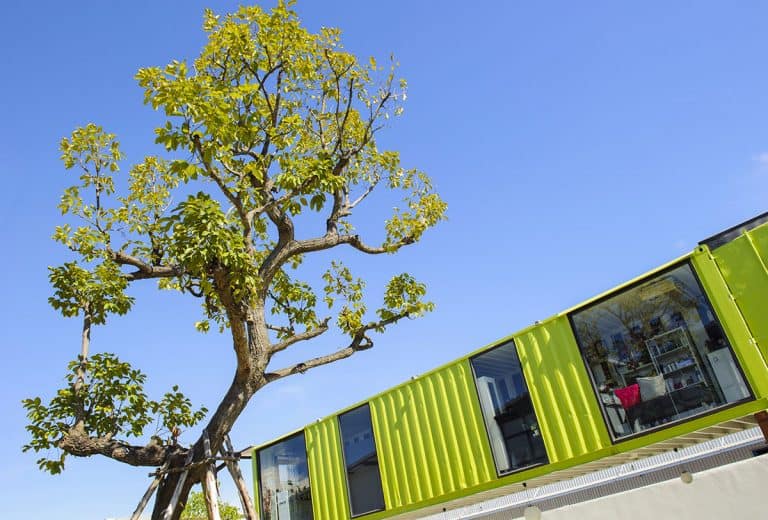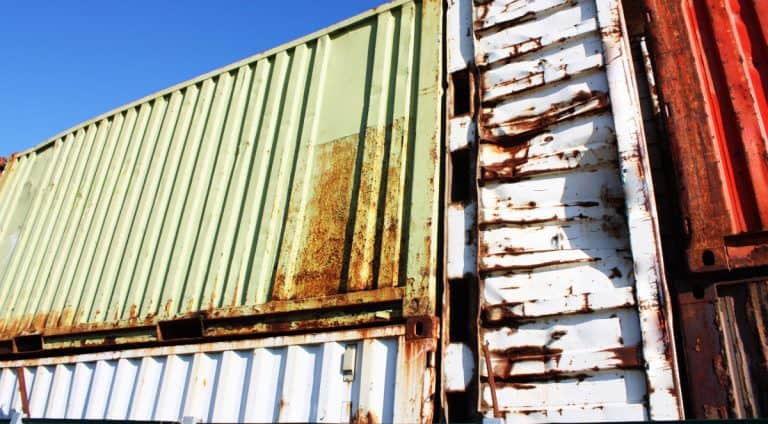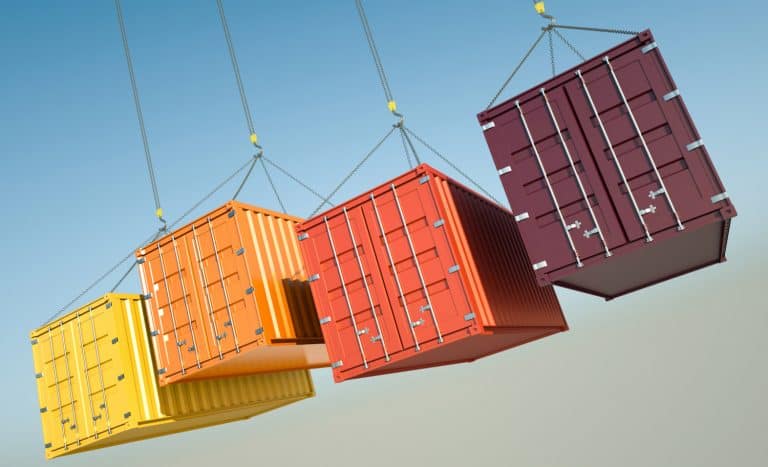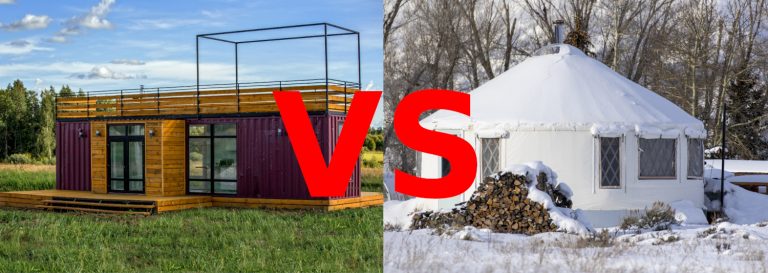18 Pros and Cons of Container Homes
Before springing for a container home, you should be aware of the many advantages and disadvantages that this alternative housing style has to offer.
Container homes are well-suited for homeowners who are looking for a sustainable living space. For starters, intermodal containers make it feasible to make a home that consists of up to 90% recycled materials. They also make it easy to install a green space on your property.
Are Container Homes Sustainable?
Container homes certainly can be sustainable, as long as construction procedures involve the installation of insulating materials like polyurethane spray foam in order to ensure that energy costs are kept down.
As much as 90% of a container home may be made of recycled materials, including all interior and exterior furnishings and fixtures. This feat can be accomplished thanks to the fact that the metal shipping containers themselves are usually recycled after spending some amount of time circulating around the world.
Container homes also leave more room for green space. These homes are usually constructed to be smaller than most other homes since the containers are usually 8×20 feet or 8×40 in length. The flat roof also offers a convenient opportunity to plant a roof garden, which has also been shown to reduce energy costs.
What are the Pros and Cons of Container Homes?
There are 18 pros and cons of container homes that will be discussed in further detail below. Going through this article will help you decide whether a container home can be a feasible alternative for you.
The advantages of container homes:
- Made of recycled materials
- Can be built quickly
- Rooftop gardens
- Durability
- Affordability
- More Yard Space
- Reduced Carbon Footprint
- Less construction waste
- Easier to finance now that building codes are being adjusted
Disadvantages of container homes:
- Not designed for windows and doors
- Utility connections may be difficult
- Limited Space
- No attic
- Waitlists for containers
- Limited design opportunities
- Financing may be hard if you don’t meet mortgage requirements regarding construction
- Require extensive insulation
Pro: Materials Used to Build Home Will be Recycled
Container homes get a point for sustainability right off the bat because they are made of recycled materials. The containers themselves would otherwise likely find a spot in a landfill or scrap yard as soon as they reach the end of their lifetime.
Container homes are perhaps the best way to repurpose the entire shipping container because most of the container will be left intact. There will be no need to cut the container up in an attempt to salvage scrap metal.
The process of converting intermodal containers into scrap metal rather than homes comes at a higher environmental cost due to:
- The need for the vehicular transport of scrap metal
- The use of tools to cut the containers apart
- The need for storage space, both for scrap metal and the inventory of containers that haven’t been processed yet
Con: There May be a Waiting List for Containers
A shipping container in decent shape can come at a premium. The value of shipping containers ebbs and flows with the state of the global economy. At times, intermodals will spend extended periods sitting empty at the harbor. If this is the case, then it should be pretty easy to chase down a recycled shipping container.
In a thriving global economy without trade deficits, it will likely be a bit harder to find a good shipping container that is recycled. Companies will have much bugger incentives to hold on to any shipping container that is usable. You won’t see very many of these in the harbor as they will be out in constant circulation.
You may find yourself on a waiting list for a container, somewhat negating the advantage of rapid construction. CNN Money reports that the containers usually are delivered within 10 weeks and assembled on-site in a day. However, during times of high demand, there can be a 6-month waiting list before a container home can be delivered, as was a case during the fall of 2014 when there was a backlog of orders.
Pro: Shipping Container Homes are Built much Faster
One of the major advantages of container homes is the speed at which they are built. This construction company claims to be able to have the roof trusses installed within 2 days and have a sealed structure within two weeks. This makes it conceivable you construct a container home in half the time that it would take to construct a traditional home of the same size.
The construction speed will ultimately depend on a number of factors:
- Size of home
- Insulation requirements
- Design complexity
- Number of windows needed
If you want to construct a home using more traditional building materials, then you will have to organize and chase down a bunch of building materials. Figuring out how much of everything you need can be an arduous process if you are designing your own home. If you are going with a container house, then this process will be much simpler. Right off the bat, much of the structure is already accounted for.
Con: Utilities Could be the Major Construction Hang-Up
Perhaps the most challenging aspect of constructing a container home is the installation of utilities. Unlike other types of modular or manufactured homes, shipping containers do not come ready for utilities. This may prolong the construction process.
If you want to qualify for a mortgage or financing, then your home will have to have a permanent foundation, pass building codes, and be connected to utilities. Accomplishing this task is likely beyond the DIY capabilities of the homeowner(s).
You are encouraged to find a qualified contractor (i.e., electrician, plumber) to install the utilities in the home. If you are looking to make a home out of mostly recycled materials, it is recommended that the plumbing and light fixtures be brand new. This ensures that the house does not become a safety hazard.
Pro: Container Homes Are Durable
There are not many better alternatives if you are looking for a durable structure. Think about it this way: shipping containers were designed to be able to withstand some pretty adverse conditions like rough seas, heavy loads, and rough handling in shipyards.
The metal container is much more rigid than other housing materials. Shipping containers are made using 14 gauge, 0.075-inch corrugated sheet steel panels that are attached to the main structure via a welding process. This does indeed leave shipping containers much more durable than any wood frame construction.
These containers are usually still in good shape after 10 years of being battered by the elements during their time in circulation. There is no reason not to believe that they will stand the test of time in their second life as a house.
The only caveat is that the container will not substitute for an actual storm shelter. Additional modifications will be needed if the container is intended for use as a storm shelter. For it to be storm-proof, it must be installed with a cement pad and secured with eight-inch brackets. The door must then lock at the top, middle, and bottom of the door.
These modifications would really only make sense in regions that are exposed to severe weather conditions like parts of Central and Southern United States. The fact that such few modifications are needed speaks volumes about the strength and durability of the shipping container itself.
Con: Design Opportunities may be Limited
You will have fewer design options with manufactured homes than you would have otherwise. Shipping container homes only come available in the rectangular shape, and you will have to work around this when it comes to both exterior and interior design.
It’s easy to see this as a negative, but many home designers have been able to rise to the occasion to find a way to make these homes more stylish. In the case of these homes, the rectangular shape is not seen as an artistic barrier. Rather it is seen as a jumping point for architecture like you’ve never seen it before.
Take, for example, this set of container homes that recently popped up around a neighborhood in Oregon. The design principles used here were pretty basic, but you can see how cozy and inviting these homes can be. You can also see how basic design elements can make the home pop by taking a look at this design idea from a property owner in Arizona.
Pro: Reduced Carbon Footprint
The carbon footprint of container homes can be significantly smaller than traditional homes. If you live in a container home, then you will have no choice but to make the most of the limited square foot footage that you do have. This is in sharp contrast to the expansive bedrooms of many other modern homes.
An estimated 39% of global carbon dioxide emissions are a result of the production of building materials and construction, according to the United Nations Environment Program. Traditional building techniques leave a larger carbon footprint because the entire home has to be built from the ground up using construction materials that come from all over the world.
Con: Container Homes can Cost Quite a Bit to Build in some Scenarios
Like any other type of home, shipping container homes can get quite expensive. And there are cases where a container home will end up costing more to build than a traditional house under similar circumstances.
Factors that can increase the building costs according to research:
- Additional reinforcement needed for the areas where the container was cut for doors or windows
- Special roofs for snowy areas
- Utility connections
Pro: The Containers are Reasonably Cheap
The added cost of transforming these structures into livable spaces can be justified by the fact that the metal containers themselves are cheap. They present themselves as a worthy alternative to traditional building materials.
Shipping container homes have been shown to save owners the most money if they are located in areas where land is cheap, but home construction is pricey.
A 20×8 foot shipping container will cost you about $2,800 in the U.S., according to Quicken Loans. The average cost of building a home continues to rise in the US, up 50% since 2002. The frame alone costs $51,589 on average, accounting for 17% of the total construction cost.
The Leader Telegram reports that container homes save owners a significant amount of cash if they are constructed in areas with high housing prices, such as Silicon Valley. For instance, the median price of a single-family home in Santa Clara County, California is $710 per square foot. By comparison, a modular (container) home costs $280 per square foot.
This even includes the cost of laying the foundation. There will, of course, be some additional costs after this, such as furnishing the house and connecting to utilities. Despite this, there is true potential for a container home to save a homeowner a lot of money in an area like California, where traditional housing comes at a premium.
Con: No Attic
Storage space can be a challenge with such a small house that doesn’t come with an attic. People may not necessarily realize how much storage space you miss out on when you don’t have an attic in your house.
Luckily people have come up with ways to maximize storage space:
One recommended way to save space in tight living conditions is to set aside dining space within the kitchen itself rather than having an entirely separate room be set up for dining purposes only.
his Winsome Suzanne 3-pc Kitchen Space Saver includes a foldable wooden table and two stools that can be stored underneath the table. All three elements have a stylish and smooth coffee finish.
Pro: You’ll Have More Yard Space
These compact homes afford you the opportunity to make more of your available yard space. This is especially true of houses that are located on small lots.
Traditionally, homeowners would be limited to a few flower beds and a small garden. Now, most of the property can be a green space.
You can further enhance the sustainability of your home and yard by adding a healthy garden. This provides a habitat space for a variety of plants and animals, some of which may be endangered and in desperate need of habitat space.
If are building your home on a small lot, then you may have to choose between having a nice yard and having a pool or patio that might end up taking up most of the green space.
There are plenty of ways to make your yard eco-friendly. Focus on adding lots of plants, shrubs, and trees that require less water and resources to grow. There are many ways to match your sustainable home with a sustainable yard, as will be discussed in further detail below.
Here are some tips for sustainable landscaping:
- Choose plants that are native to your climate zone
- Install a drip-irrigation system for watering
- Add a hummingbird feeder or other type of habitat feature
- Install LED outdoor lighting if you are going to light your porch
Con: These Homes Are Difficult To Keep Cool Or Warm
The steel structure of the shipping container does not lend itself to being easy to keep cool or warm in climates with varying temperatures. You will need to install some form of insulation or some efficient cooling/heating system if you want to keep the interior temperature of the home regulated.
Fortunately, others have found a formula for success when it comes to insulating a container home. This involves multiple steps. First, you will spray flexible foam insulation around the perimeter of doors and windows as well as around the 2x4s in the wood frame. Then more substantial insulation will be added.
Materials may include:
- Spray Foam insulation along the perimeter of windows, door and wood 2x4s in the frame
- Rigid insulation for easy DIY installation
- Ceiling insulation
- Radiant barriers in hot and sunny climates
The rigid insulation will be good for DIY installers. However, expanding polyurethane foam is considered by many to be a superior product to the rigid insulation. This is because it molds to the contours of the shipping container, making use of available space and reducing the amount of heat transfer to a greater degree.
Insulation requirements will vary depending upon the climate zone you live in. If you live in a hot and sunny climate, you will find that a radiant barrier will vastly cut down on the amount of radiant heat transfer that occurs.
Read more about how to stay cool in a container home.
Pro: Good For Rooftop Gardens
The rectangular shape of container homes makes them supportive of rooftop gardens. Living roofs actually help reduce energy costs by as much as 8%. This is another design feature that also makes these homes more visually-appealing than most other homes.
Living roofs with soil beds 6-24 inches in depth are capable of supporting more edible produce. Roofs less than 6 inches in depth will usually only be supportive of grasses and herbs. Most importantly, roof gardens with deeper soil beds are more effective at reflecting heat.
As for which plants you should be using for your green roof, focus on plants that can thrive in your climate zone with little water. Sedum is a popular choice for rooftop gardens. This variety, called Stonecrop, is known for being particularly tough. You can certainly add more variety to the rooftop garden as you wish, but much of the space will typically need to be a low-maintenance plant.
Pro: Shipped Right To Your Property
Intermodal containers are delivered to you with very little effort needed on your part. The intermodal is loaded onto a roll-off tractor-trailer. Once the truck reaches the destination, it can take as little as 15 minutes, according to Western Container Sales.
Some services will even build prefabricated container homes. Honomobo is one of these companies that offers prefab container homes. Many different floor plans are available, including a container that is cut down to exist as a quiet office space in your backyard. The containers come with all the interior and exterior factors already installed. The prefab includes connections and wiring for utilities.
Have the company prefab the hardest parts of the construction process. Curing out spaces for windows and doors can be an arduous task, particularly since these structures are made out of metal. It is also difficult to plan out exactly how the interior and exterior features should be plotted out. These prefab structures are designed by experts who know how to maximize the limited space inside the container.
Con: It can be hard to find Shipping Containers
Sometimes it will be easy to find a quality shipping container while other times, it will be quite difficult. The availability of shipping containers will depend largely on the state of the global economy. If there is less international trade between countries, then there will be a larger inventory of shipping containers not being used.
In times of low trade activity, shipping companies will be tempted to sell at least some of their inventory of unused containers. This was the case during the 2014 U.S. trade deficit in which the market was flooded with lightly-used intermodals.
Other times good shipping containers will come at a premium. The demand for shipping services will drive container costs up, and it may be more difficult to locate a container capable of supporting a home that also comes at an affordable price.
Pro: Container Homes Produce less Construction Waste
One of the biggest benefits from an environmental standpoint is the fact that container homes can produce less construction waste both during and after the initial construction process.
This starts with fewer building materials needed thanks to the metal frame of the containers. There will also be less packaging since the container itself does not come in a bunch of different packages that may ultimately find their way to landfills.
Since container homes can be made mostly out of recycled parts, there will also be less waste produced by the harvesting and manufacturing of the massive amount of lumber that is needed to build traditional homes with a wood frame.
Con: Building Codes and Financing
With any new home, you will have to ensure that you will be able to secure the necessary permits. Local building codes do vary, so be sure that you check the regulations while you are in the planning process. It is never a good idea to invest in properties without doing the necessary homework first.
It should also be noted that the construction details will dictate whether you are able to qualify for a mortgage or receive financing. Stipulations for financing will likely include the requirement to pass building codes, include a permanent foundation and utility connections.
Meeting these requirements may be more difficult with shipping container homes. These types of homes do not typically qualify as real estate unless there is a permanent foundation and utilities. You will need to get a recorded plat and a recorded title, according to Quicken Loans.
This is something to consider if it is off-the-grid living that you desire. The costs associated with this lifestyle extends beyond the construction process and the search for a sustainable energy source. Consider whether you would be able to afford the house if you cannot qualify for a mortgage or personal loan.
Pro: More and more Places are Becoming Friendly to Shipping Containers
Cities and towns are starting to latch onto the shipping container home revolution. These kinds of houses have shown serious potential as a source of affordable housing that can be constructed at a rapid rate. As such, local governments are beginning to transform their building codes to be more friendly to container homes.
As an example, the State of Washington has put in place an approval process for container homes to meet the building codes. As governments offer a clear pathway for container homes to pass building codes, there will be a lot fewer headaches for those intrigued by this unique housing opportunity.
Despite the positive trend, not all jurisdictions have adopted the use of containers as construction materials yet. Note how confusing it can be when municipalities have not yet adopted building codes specific to container homes by looking at this answer from Los Angeles County.
The county notes that it may be difficult to justify the construction of these homes to code enforcement without a clear pathway in place for getting this structure to pass code.






